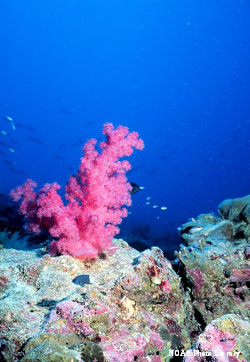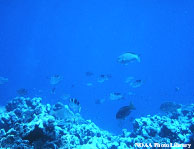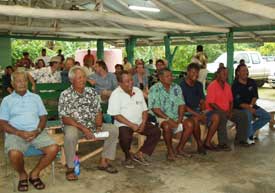You are here: Home › Ecosystems › Coral Reefs › Current Programs › Coral Reef Ecosystem Studies - Micronesia
Coral Reef Ecosystem Studies – Micronesia
“Coral Reef Ecosystem Integrity and Restoration Options with Watershed-based activities and Marine Protected Areas (MPAs) in the Tropical Pacific Islands”
Issue
 Coral
reefs are highly diverse, productive and complex ecosystems.
They build tropical islands and land masses, protect their
shores from coastal erosion and wave damage, support fisheries
of cultural and economic value, function as a repository
for natural products of biomedical value and are truly museums
of the world’s tropical marine biodiversity. While
coral reefs are relatively robust and have survived millions
of years of natural disturbances, anthropogenic influences
are a major concern for the sustainability of these important
ecosystems.
Coral
reefs are highly diverse, productive and complex ecosystems.
They build tropical islands and land masses, protect their
shores from coastal erosion and wave damage, support fisheries
of cultural and economic value, function as a repository
for natural products of biomedical value and are truly museums
of the world’s tropical marine biodiversity. While
coral reefs are relatively robust and have survived millions
of years of natural disturbances, anthropogenic influences
are a major concern for the sustainability of these important
ecosystems.
Due to the small size of the islands of Micronesia, activities conducted within watersheds have almost immediate effects on coastal coral reefs. Runoff, sedimentation and non-point source pollution are among the greatest threats to coral reefs and reef fisheries throughout the Pacific Basin. The societal costs of coral reef degradation resulting from land-based developments are great, especially when considering the importance of coral reefs to island cultures.
Approach
(MPAs) in the Tropical Pacific Islands study, focused on Guam will:
- Apply the knowledge gained from previous studies determining the classes and concentrations of coastal pollutants associated with watershed discharge of greatest concern to coral reef health
- Collect quantitative data on physical and chemical characteristics of coastal waters affected by watershed discharge and apply these to developing integrated management schemes
- Provide an accurate assessment of the societal costs of insufficient environmental protection measures within watersheds and coastal waters as they affect reefs and related coastal marine resources
- Determine if coral reef restoration activities are practical if coupled with watershed restoration efforts, establishment of MPA’s and pollution abatement, and
- Make this information readily accessible to stakeholders as a means of affecting appropriate environmental policy.
 Methods
include performing ecological studies on coral reefs, studying
coastal water characteristics of flow, residence time and
spatial extent of watershed discharge, quantifying the societal
costs to island communities resulting from watershed and
related reef degradation, and testing reef restoration techniques
coupled with established MPA’s and land-based remediation.
Methods
include performing ecological studies on coral reefs, studying
coastal water characteristics of flow, residence time and
spatial extent of watershed discharge, quantifying the societal
costs to island communities resulting from watershed and
related reef degradation, and testing reef restoration techniques
coupled with established MPA’s and land-based remediation.
Management and Policy Implications
The research integrates ecological studies, physical oceanographic research and social science to deal with problems identified as priorities by the US Coral Reef Task Force. It will focus on the anthropogenic disturbances of great impact on coral reefs and translate this information for regional educational outreach.
Accomplishments
The CRES-Micronesia project has allowed researchers to answer critical questions on biological responses, develop scientifically-based policy recommendations, and carry these through to implementation. CRES-Micronesia researchers have developed two new models. The first, quantifies the spatial and temporal extent of watershed discharges onto coastal coral reefs, based on watershed catchments, receiving water, meteorological, and biological attributes. This HOME model is based on Hydrology, Oceanography, Meteorology and Ecology, and is presently being applied to coral reefs ranging in scale from the Great Barrier Reef in Australia to the Ngerikill Reef in Palau. The second model is the first of its kind to quantify changes in the biological community structure on coral reefs along a gradient of watershed discharges.
A key outcome of the NOAA grant, in addition to peer-reviewed publications and the development of a watershed model to predict the effects of land-based pollutants on coral reef ecosystems, has been in regional capacity development of a highly under-represented group in the NOAA sciences, namely Pacific Islanders, as seen in the following example:

Two of the associate investigators involved in this program are Palauans that are now helping develop additional regional capacity throughout the region and serve as role models for other islanders to pursue careers in the NOAA core sciences. They are the Chief researchers at the Palau International Coral Reef Center, and it is through their participation that we have one of the best examples of implementation. Following a period of data collection, these two researchers developed a presentation in the Palauan language for the chiefs and fishermen from the nearby village that tied coral reef and fisheries losses to destruction of the coastal mangroves fringing the bay. In a traditional village meeting house, using PowerPoint, they explained what was happening due to the clearing and grading activities, demonstrated the level of coral reef and fisheries losses, and made a number of recommendations. Within six weeks of this presentation, the Airai State government implemented a moratorium on cutting and filling the mangroves, which is still in place over two years later. Subsequently, national legislation has been introduced to address mangrove protection. One of the Palauan researchers is now pursuing his Ph.D. and part of his dissertation research will be undertaken under the NOAA grant. If successful, he will be Palau’s first Ph.D. in this area of expertise. The biological model mentioned above was developed by another Pacific Islander as part of his Masterís Thesis, and this individual will become the Director of Environmental Protection in the Cook Islands later this year.
For more information contact:

